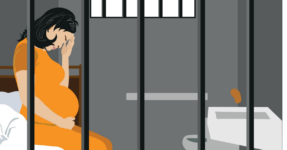Should Women Be Sent to Prison While Pregnant?

Back in 2018, a mainstream media organisation produced a news report about women who give birth in custody.
The two-minute video made the purpose-built facilities for mothers and their babies in New South Wales prisons seem like a compassionate solution to a very real issue – women giving birth behind bars.
Interestingly, around the same time, news stories emerged about a woman named ‘Amy’ who gave birth alone in a cell in Bandyup Women’s prison in Western Australia, without pain relief, or medical care. The baby was born four weeks prematurely.
A subsequent investigation determined that despite Amy calling for help for more than an hour, staff were unable to find keys to access her cell.
The independent inspector of WA Correctional Services made a list of recommendations including an expansion of adequate infrastructure for women in late stages of pregnancy, including medical and nursery facilities.
But then in 2020, a report released by the same government department detailed the alarming routine use of restraints such as handcuffs and shackles in Western Australian prisons, including on pregnant women.
The need for a national standard of care for pregnant women behind bars
Suffice to say that the experience of pregnant women behind bars appears to be very different depending on which state or facility these women find themselves in, which suggests that it is time we developed a national standard of care for pregnant women behind bars.
It’s probably not surprising given their over-representation in the prison system generally, Indigenous women make up the majority of incarcerated mothers.
The numbers of pregnant women are not easy to come by because correctional facilities in Australia are the responsibility of the state and territory governments, but it’s estimated that one in two imprisoned women are mothers, and approximately 5-10% are pregnant.
The ages of children currently living in prison ranges from newborn to up to five years of age.
There are thirteen correctional facilities around Australia that cater for mothers and babies, but concerns persist that the medical needs of pregnant women behind bars are not being sufficiently met.
Part of the debate is, of course, the part that the interests of unborn and soon-to-be born children should be considered when determining whether to imprison pregnant women; especially women with underlying issues such as chronic health problems, and drug or alcohol depdence.
More generally, is it a good idea to put pregnant women behind bars in the first place.
In the United States
Currently in the US, defence lawyers for a woman being held in custody since mid-2020, accused of murder, have lodged a ‘Habeas Corpus’ petition (for a hearing to be held in front of a Judge) with regard to the woman’s release, based on the fact she is not receiving adequate pre-natal care, and the baby’s constitutional rights have been violated because it is not charged with any crime.
The woman is being held on remand – meaning that their trial is yet to begin. And, a cornerstone of the justice system in a Western Democracy is the entitlement to the presumption of innocence until determined otherwise by a court of law.
This particular case highlights the ethics of locking up pregnant women, highlighting the rights of the innocent unborn child.
The law in the US, like Australia and like the UK, makes no distinction between a pregnant woman or any other offender, although in Australia individual judges or magistrates do have the power to take into account an individual’s circumstances when sentencing, and may (or may not) make some considerations for a pregnant woman who would give birth behind bars.
A difficult issue
Of course, most people would agree that allowing Mothers and babies to stay together as long as possible is a good thing – we know from years of evidence-based research that the quality of a baby’s bond with its mother or primary carer affects a child’s early social and emotional development.
Although this needs to be weighed up carefully against children’s other rights and long-term outcomes for children who spend their early years in prisons, which are not equipped for children, as well as the potential impact on deterrence of allowing pregnant to effectively put off their terms of imprisonment.
Around the globe there is little research about the impact of this.
Alternatives to non-custodial sentences abroad
And while some parts of the world allow pregnant women to serve their sentences at a later time – as is currently the case for convicted fraud offender and founder of pharmaceutical company Theranos, Elizabeth Holmes, there are nations which only impose non-custodial penalties on pregnant women.
For example, in Peru non-custodial measures for women are prioritised during pregnancy and for mothers with children under the age of three.
Mexico’s Federal Code of Criminal Procedure prioritises house arrest for pregnant women, and nursing mothers, as well as older persons and people with a ‘serious or terminal illness’.
In the Ukraine, when it comes to punishing pregnant women or a woman with children under seven years of age, ‘except for persons sentenced to imprisonment for a term more than five years for grave criminal offences, a court may discharge such persons from both primary and additional punishments on probation for a period of leave granted by law to women in view of pregnancy, or childbirth until the child attains seven years of age’.
In Russia, the court may postpone the serving of a custodial punishment in the case of a convicted pregnant woman. This rule applies also to a woman with a child who is under fourteen, or a man with a child under fourteen who is the only parent, except for those convicted for sex offences against minors or very serious crimes.
At the other end of the spectrum, countries such as the Philippines which have no special facilities for pregnant women and babies, in the prison system, mothers and their babies are separated at birth.
It’s a highly emotive issue.
Hardship considerations during sentencing
All states and territories across Australia have laws in place whereby special harships caused by full time custodial sentences can be taken into account during the sentencing process.
For Commonwealth offences, the provision for this is contained in section 16A of the Crimes Act 1914 (Cth) , which permits judges and magistrates to consider the hardship that would be caused to an offender’s family and dependents when determining a sentence.
And, although it is generally considered that these circumstances need to be ‘exceptional’ for hardship to offspring to be a factor that influences sentencing, it is one provision within sentencing law that allows courts to give consideration to pregnant women giving birth behind bars, as well as other children an offender may care for.
Undoubtedly, sentencing a parent has the potential to have considerable impact on a child and this needs serious consideration. There are calls for sentencing of pregnant women and mothers to be a last resort.
If, in Australia, we cannot commit to that, then we most definitely need a national care standard for these women and their children while they are serving their sentences. And it is a matter of some urgency – the numbers show that between 2009 and 2019. But we also need to take into account the danger of women becoming pregnant to avoid or defer going to prison.
Australia’s female prison population increased by 64% in Australia. And while the numbers declined temporarily in 2020, they rose again in 2021.






